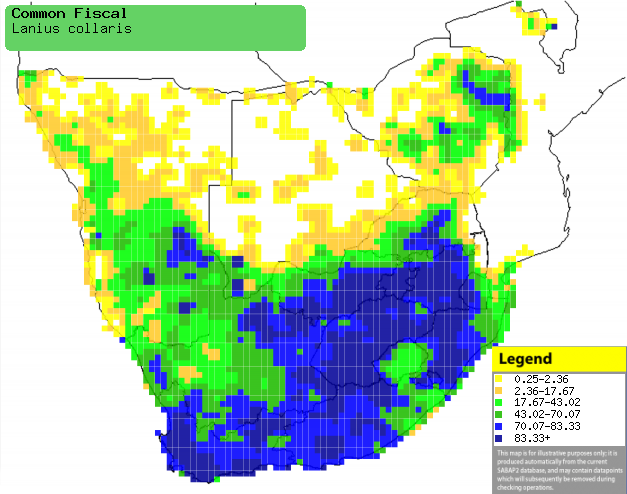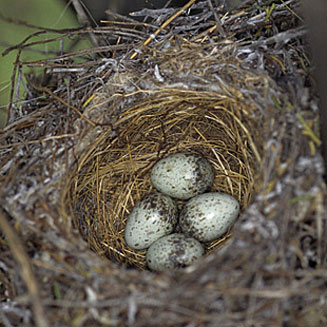Lanius collaris (Common
fiscal, Fiscal shrike)
Fiskaallaksman [Afrikaans]; Inxanxadi, Umxhomi [Xhosa]; iLunga, iQola [Zulu];
Nankuwo (generic term for shrike) [Kwangali]; Temeli (also applied to
Red-backed shrike and Lesser grey shrike) [South Sotho]; Korera [Shona]; Juka,
Rhiyani (these terms also applied to Lesser grey shrike) [Tsonga]; Tlhômêdi
[Tswana]; Gekraagde klauwier [Dutch]; Pie-grièche fiscale [French];
Fiskalwürger [German]; Picanço-fiscal [Portuguese]
Life
> Eukaryotes >
Opisthokonta
> Metazoa (animals) >
Bilateria >
Deuterostomia > Chordata >
Craniata > Vertebrata (vertebrates) > Gnathostomata (jawed
vertebrates) > Teleostomi (teleost fish) > Osteichthyes (bony fish) > Class:
Sarcopterygii (lobe-finned
fish) > Stegocephalia (terrestrial
vertebrates) > Tetrapoda
(four-legged vertebrates) > Reptiliomorpha > Amniota >
Reptilia (reptiles) >
Romeriida > Diapsida > Archosauromorpha > Archosauria >
Dinosauria
(dinosaurs) > Saurischia > Theropoda (bipedal predatory dinosaurs) >
Coelurosauria > Maniraptora > Aves
(birds) > Order: Passeriformes
> Family: Laniidae
Distribution and habitat
Widespread across sub-Saharan Africa, absent from much of
the DRC, Somalia and Ethiopia. In southern Africa it occurs almost everywhere in
South Africa, extending into much of Namibia, Zimbabwe and southern Botswana. It
occupies a wide variety of habitats but generally prefers open habitats with
scattered trees, such as savanna, open woodland, shrubland and grassland. It is
also extremely common in man-made habitats such as gardens, parks, farmland and
roadsides.
|
 |
|
Distribution of Common fiscal in southern Africa,
based on statistical smoothing of the records from first SA Bird Atlas
Project (©
Animal Demography unit, University of
Cape Town; smoothing by Birgit Erni and Francesca Little). Colours range
from dark blue (most common) through to yellow (least common).
See here for the latest distribution
from the SABAP2. |
Brood parasites
It has been recorded as host of the
Jacobin cuckoo.
Food
One of the reasons of this species success lies in its
varied diet and clever hunting techniques. It often uses a sit and wait
technique in which it hunts from a prominent perch, remaining almost motionless,
scanning the area with its sharp eyes. When it spots something it glides to the
ground and attempts to catch its prey. If the food item is small it usually eats
it on the spot, but if it is larger it either eats it on its perch or impales
the animal on a thorn barbed wire. It often uses specific thorny tree or
barbed wire fence as a "larder", sometimes storing dozens of animals at one
site. It eats a variety of animal prey, such as invertebrates, birds and their chicks and
small rodents. The following food items have been recorded in its diet:
- Animals
- insects
-
Lepidoptera
- moths
- Imbrasia cytherea (Pine-tree emperor moth)
- Bombycomorpha bifasciata (Barred eggarlet)
-
caterpillars
-
Orthoptera
- grasshoppers
- Zonacerus elegans (wingless locusts)
- stink locusts (Phymateus)
- dung beetles
-
Diptera (flies)
- Boophilus decoloratus (Blue tick)
- frogs
- Tomopterna delalandii (Cape sand frog)
- Xenopus laevis (Common platanna tadpoles)
- reptiles
- birds
- mammals
- Rhabdomys pumilio (Striped field mouse)
- Eptesicus capensis (Cape serotine bat)
- Salmo trutta (Brown trout)
- Fruit
- Scutia myrtina (Cat-thorn)
- Ficus (figs)
Breeding
- It is a monogamous, highly territorial solitary nester. Males defend their
territory ferociously against other males, often grabbing their opponent
with their claws and then pecking them repeatedly.
- The female handles most of the nest construction, a process which lasts
2-5 days. It is a thickly walled cup made of twigs, flower heads, bark,
grass, leafy herbs and moss, sometimes also including paper, rags, spider
web, feathers and cocoons. It is usually placed in the fork of a thorny bush
or small tree, building a new nest each breeding season.
 |
|
|
Common fiscal nest with eggs, Wakkerstroom, South
Africa. [photo Warwick Tarboton ©] |
|
- Typically 2-3 broods are produced within the breeding season each
consisting of a 1-5, usually 3-4 egg clutch. These are incubated mainly by
the female for 12-16 days.
- The chicks are fed mainly by the mostly the female in the first week,
after which the male gradually takes more responsibility. They stay in the
nest for about 14-21 days and can feed for themselves about 3 weeks later.
However, they only become independent after a few more weeks, leaving their
parents territory at about 4 months old.
Threats
Not threatened, in fact widespread and common.
Links
References
-
Hockey PAR, Dean WRJ and Ryan PG 2005. Roberts
- Birds of southern Africa, VIIth ed. The Trustees of the John Voelcker
Bird Book Fund, Cape Town.
|
